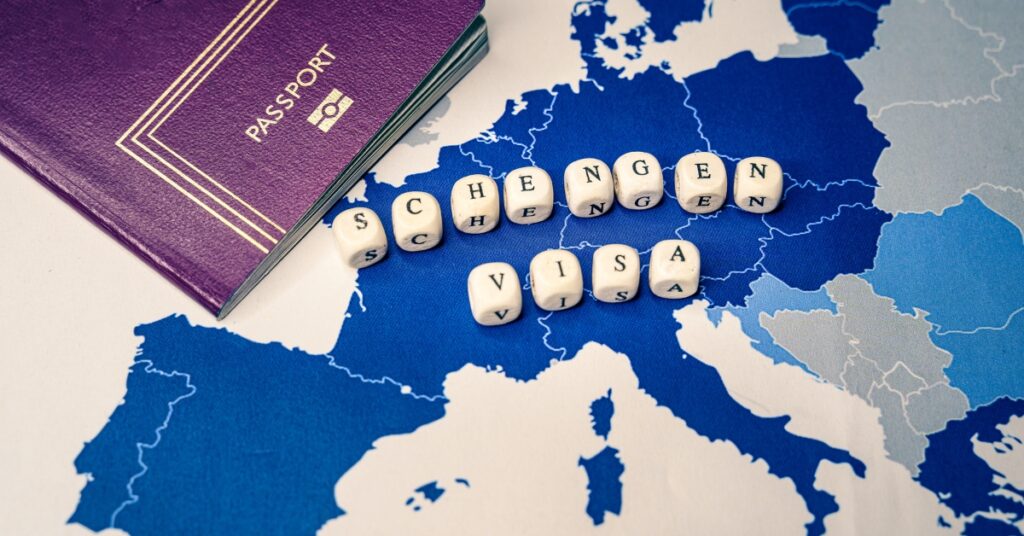Need a visa for travel? Our blog, “Worldwide Visa Guide,” simplifies it all. Find quick tips on getting visas for any country. Simple, fast, and clear.
Table of Contents
What Is a Visa?
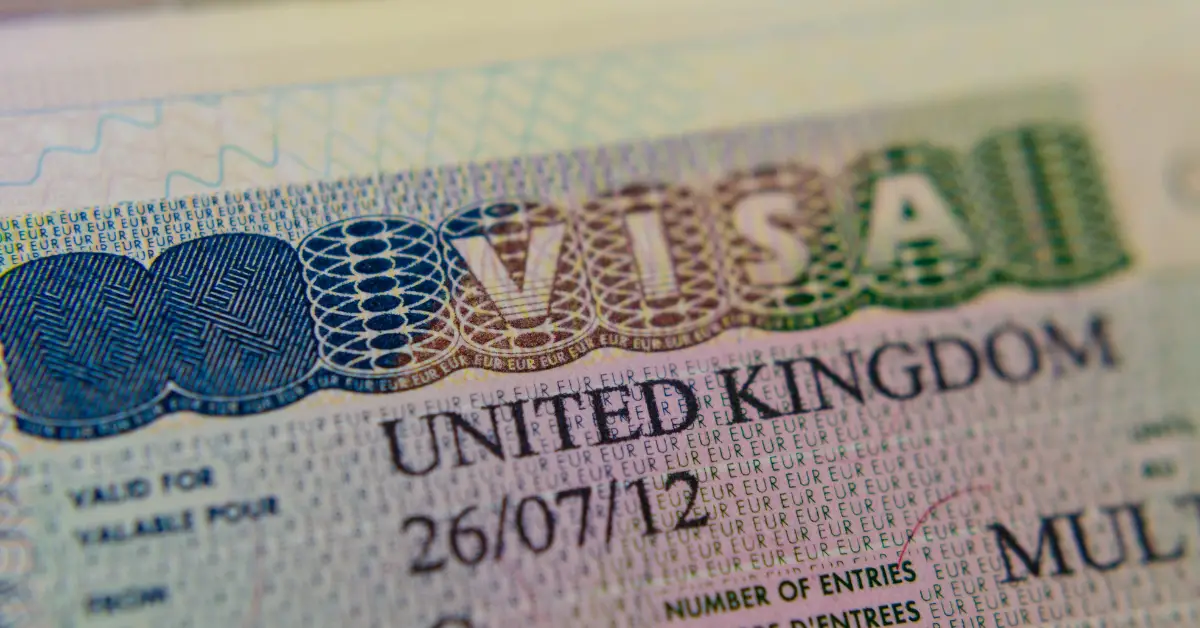
A visa is an official document issued by a government that grants permission to enter a foreign country for a specific period.
A visa is issued by the country where you are traveling to.
It is usually obtained before traveling through an embassy, consulate, or online application, although some countries offer visas on arrival.
Typically attached to your passport, a visa specifies the duration of your stay.
Sometimes, it will be a sticker or stamp on your passport page.
Countries use visas as a security measure to monitor who enters and to prevent illegal immigration.
They defend against security risks, helping control who can cross borders and ensuring visitors comply with the country’s laws and regulations.
For example:
Think of it like a hand band to a nightclub. You could only enter the club with a valid hand band.
What Does a Visa Look Like?
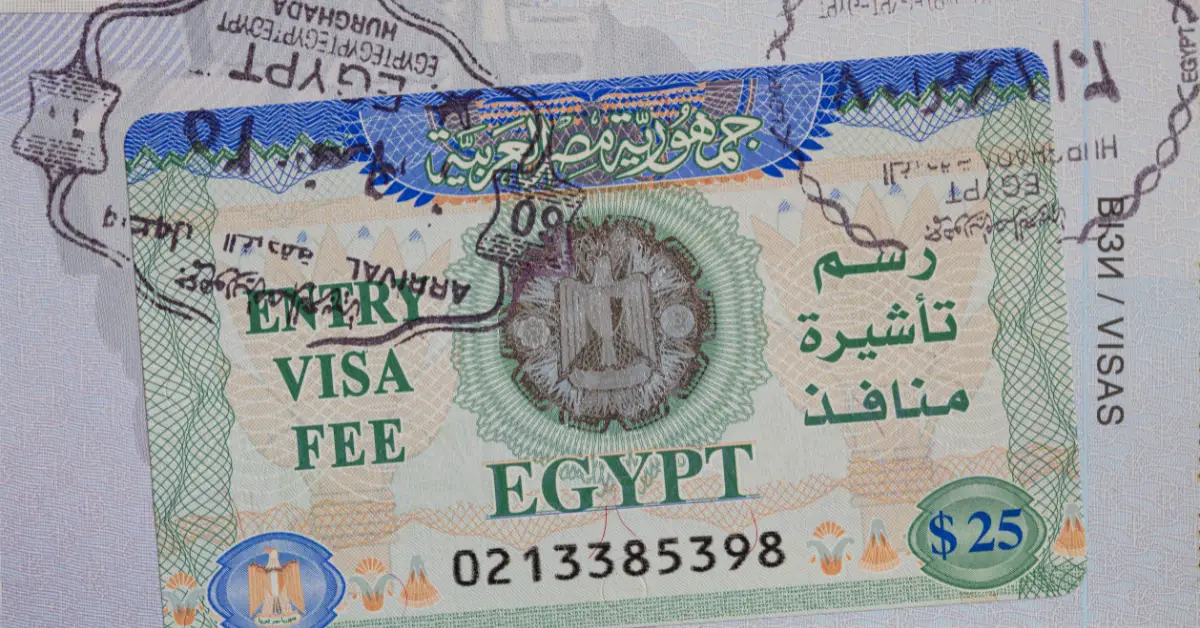
A visa typically appears as a sticker attached to a page in your passport.
These are the most common type, typically glued or stapled onto a designated page in your passport.
Information like:
- Your Name
- Photo
- Passport Number
- Visa Type
- Issuing Country
- Date Of Issuance
- Validity Period
Some sticker visas might also have additional security features like holograms or watermarks.
In some cases, it will be a stamp on the passport page that says the arrival and departure of the traveler, as shown in the image below. 👇
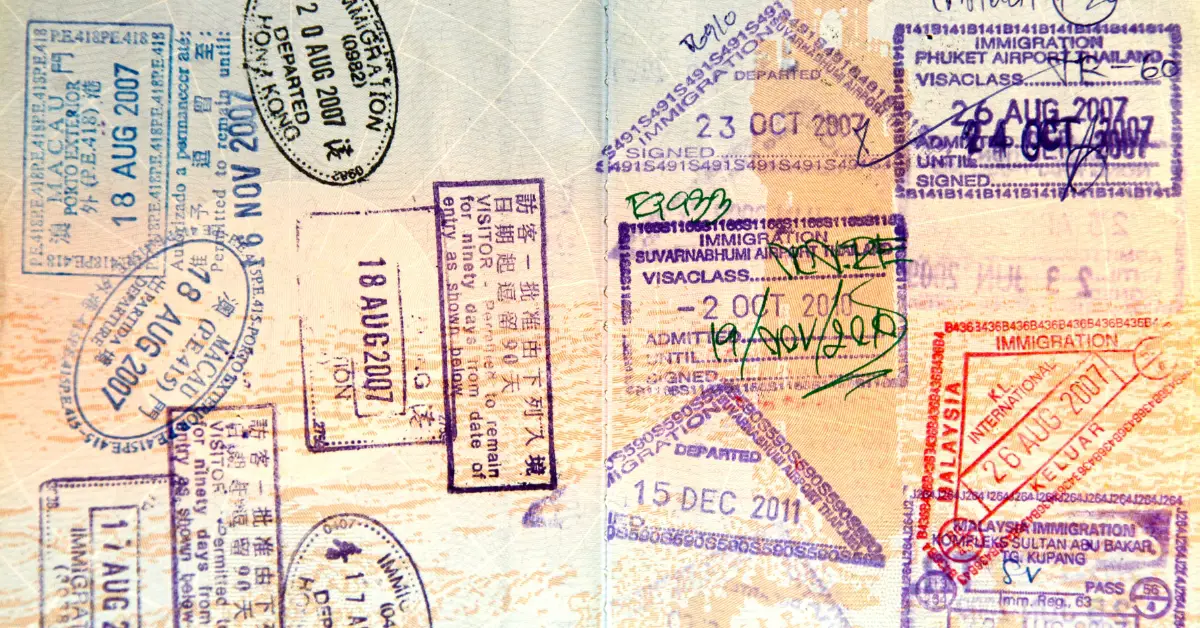
In certain cases, visas are issued as separate documents rather than being attached to a passport.
One common example of this is electronic visas (e-visas).
E-visas are obtained online; travelers must print them and carry them with their passports.
These types of visas are increasingly popular as they offer a more convenient application process for travelers.
A Brief History of Travel Visas
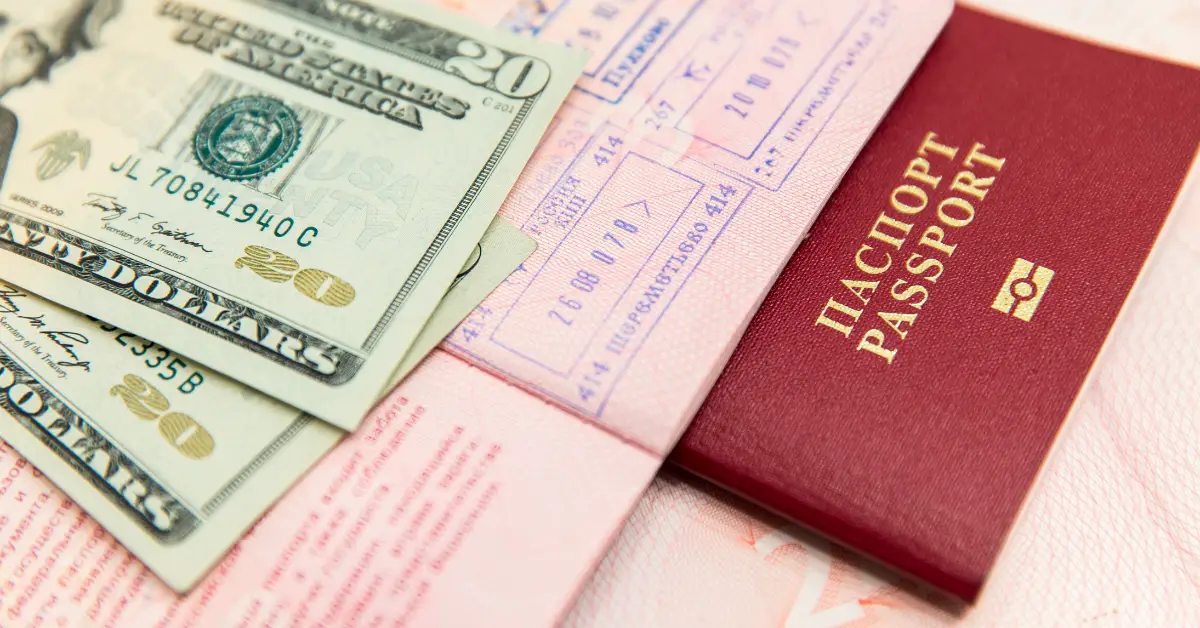
The journey of travel visas, from ancient permissions to modern-day gatekeepers, is a fascinating story of evolution and adaptation.
Here is an in-depth look at this transformation:
Ancient World: Early Glimmers of Control
- 450 BC: In the Book of Nehemiah from the Bible, a Persian king grants a letter of safe passage, one of the earliest forms of travel authorization.
- Roman Empire: Emperors issued “diploma” documents for official travel and trade, facilitating movement within the empire and offering protection.
Medieval Era: Letters of Commendation and Safe Passage
- 14th-15th Centuries: European monarchs provided “letters of passage” or “safe conduct” to ensure the safety of travelers, mainly for diplomatic or religious reasons.
- 16th Century: The emergence of passports as handwritten documents detailing the traveler’s identity, purpose, and destination.
Early Modern World: Standardization and Control
- 18th-19th Centuries: The standardization of passports, transitioning to printed forms and centralized government issuance. Visas emerged as separate endorsements within passports for specific activities like trade or temporary stays.
- Early 20th Century: The rise of nation-states and concerns about security and immigration led to stricter visa requirements for international travel.
Post-World Wars: Modern Visa Regimes Take Shape
- World War I: Passports and visas became mandatory for most international travels due to espionage and national security concerns.
- Post-WWII: The International Civil Aviation Organization (ICAO) promoted the standardization of travel documents, including visas.
Late 20th-21st Centuries: Technology Revolutionizes Travel
- Advancements led to the development of electronic visas (e-Visas) and visa-on-arrival systems, simplifying travel for certain nationalities and destinations.
The Future of Travel Visas: Balancing Security and Openness
- Biometric Data and Digitalization: Integrating biometric data like fingerprints and facial recognition to enhance security and streamline visa processing.
- Visa-free Travel Zones and Regional Agreements: The Schengen Area in Europe is an example of an initiatives to facilitate free movement within certain regions.
- Balancing Act: Governments are challenged to balance border control with the need to promote tourism and international trade.
Travel visas have transformed from simple letters of passage to multifaceted documents, pivotal in the global movement.
With evolving technology and geopolitical landscapes, the future of visas will likely see further innovation and adaptation, addressing the dynamic needs of an interconnected world.
The Thales Group article discusses the evolution of travel technology, emphasizing digital advancements like Electronic Visa Authorization Systems and cloud-based passports. These innovations aim to streamline travel processes, enhance security, and improve the traveler experience by reducing dependency on physical documents. The article also covers various global efforts to integrate these technologies into national and international travel infrastructure.You can read the full article on the Thales Group’s website for a comprehensive understanding.
Thales Group
Visa Types – Purpose, Duration, Requirement, Features
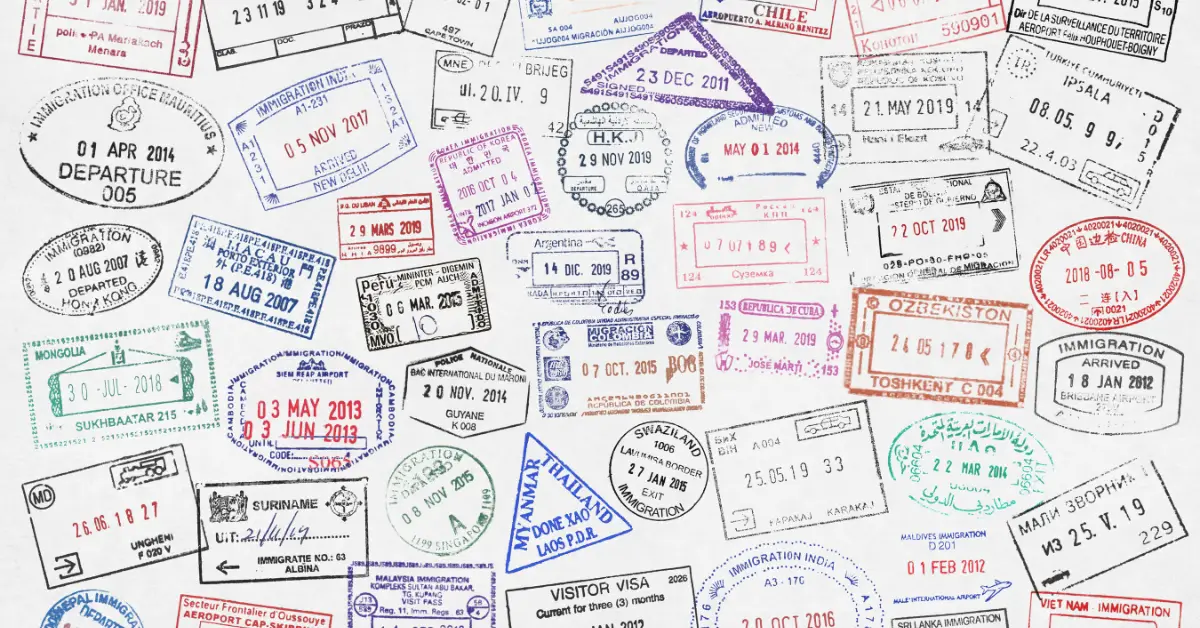
Visa types are as diverse as the reasons people travel, each with its specific purpose and requirements. To obtain a visa from any country, a passport is a mandatory document.
Here is a breakdown of some common visa categories based on the traveler’s intent:
Tourist Visas
- Purpose: For short-term leisure visits, sightseeing, and vacations.
- Duration: Usually valid for 30-90 days, with some allowing multiple entries within a specific period.
- Requirements: Common requirements include proof of financial support and return tickets.
Business Visas
- Purpose: Attending meetings, conferences, or conducting business activities without employment.
- Features: These may require invitations from business partners or companies in the destination country, and they often have multiple entry options for frequent travelers.
Work Visas
- Purpose: For taking up paid employment in a foreign country.
- Requirements: Require sponsorship from an employer in the destination country, with different categories for skilled and unskilled workers and temporary and permanent jobs.
Student Visas
- Purpose: To pursue academic studies at accredited institutions in a foreign country.
- Requirements: Proof of enrollment and financial support for the duration of studies are required and may have restrictions on working during studies.
Transit Visas
- Purpose: Passing through a country without formally entering it, typically at an airport.
- Features: May be required for layovers or connecting flights, valid for a limited time within the airport transit area.
Family/Dependent Visas
- Purpose: For joining family members who are already residents or citizens of the destination country.
- Requirements: Proof of relationship and financial support from the sponsor are needed, which may lead to permanent residency pathways in some cases.
Medical Visas
- Purpose: For seeking medical treatment in a foreign country.
- Requirements: Proof of medical condition, treatment plan, and financial resources are required and may have restrictions on the duration of stay and activities permitted.
Diplomatic Visas
- Purpose: For official representatives of governments and international organizations.
- Features: Issued based on diplomatic agreements and reciprocity, grant special privileges and immunities within the host country.
Cultural Exchange Visas
- Purpose: Participate in cultural programs, research, or professional development activities.
- Requirements: Sponsored by cultural institutions or exchange programs, may have specific restrictions on duration and activities permitted.
Other Special Visas
- Purpose: Some countries issue unique visas for volunteering, religious activities, or humanitarian work.
- Features: Requirements and conditions vary depending on the type of visa and issuing country.
Remember, visa requirements can vary significantly depending on the specific country and individual circumstances.
It is crucial to research the specific visa types and requirements well in advance of your travel plans.
What is Visa-Free Travel?

Visa-free travel allows individuals to enter a country without securing a visa beforehand.
This means travelers can board a flight and present their passports upon arrival, bypassing the traditional visa application process.
This form of travel is particularly appealing for its convenience and cost-effectiveness, allowing more spontaneous and flexible trip planning.
Benefits of Visa-Free Travel
- Spontaneity: It makes planning trips easier and more flexible, as there’s no need to worry about visa applications and processing times.
- Cost Savings: Visa applications often involve fees, particularly for multiple destinations. Visa-free travel eliminates these expenses, making travel more budget-friendly.
- Reduced Stress: The visa application process can be uncertain and stressful. Visa-free travel removes this burden, allowing travelers to focus on enjoying their journey.
Who Can Travel Visa-Free?
The privilege of visa-free travel depends on diplomatic relations, economic ties, and reciprocity agreements between countries.
It varies based on one’s nationality and the destination country.
How to Find Out if You Can Travel Visa-Free?
- Official Government Websites: These usually have sections detailing visa requirements and exemptions for different nationalities.
- Visa Checker Tools: Online tools where you input your passport nationality and destination to check visa requirements.
- Embassies and Consulates: Contacting the embassy or consulate of your destination country provides reliable and up-to-date visa information.
Popular Visa-Free Destinations
- Southeast Asia: Countries like Singapore, Thailand, Malaysia, Indonesia, and Vietnam offer visa-free entry for many European and North American passport holders.
- South America: Ecuador, Peru, Bolivia, and Colombia are accessible visa-free for short stays to numerous nationalities.
- Caribbean: The Bahamas, Dominica, Grenada, Saint Vincent and the Grenadines welcome a range of nationalities without visas.
- Oceania: Nations such as Micronesia, Palau, Fiji, and Samoa allow visa-free entry for many.
Important Considerations
- No Guarantee of Entry: Visa-free travel does not ensure entry; immigration officials can deny access if they suspect any violation of immigration laws.
- Limitations: There are often restrictions, like maximum stay durations and limitations on the activities you can engage in.
- Stay Informed: Always check the most current visa requirements before traveling, as regulations can change.
Visa-free travel enhances the ease of international travel, offering a less stressful and more cost-effective way to explore the world.
However, staying informed and understanding each destination’s specific regulations and limitations is crucial.
Ways to Get a Travel Visa

Navigating the world of travel visas can initially seem daunting, but with the right information and preparation, it can be a surprisingly smooth process.
Understanding the visa process is crucial when planning a vacation, a business trip, or a longer stay abroad.
Here is a step-by-step guide to help you navigate this journey.
Research the Visa Requirements
Destination Country
- Official Sources: Start by researching the specific visa requirements for your chosen destination. The country’s official immigration website or embassy/consulate website will be your most reliable source of information.
Type of Visa
- Purpose of Travel: Different types of visas exist for various purposes, such as tourist, business, and work. Identify the visa type that best aligns with your travel purpose.
Gather Required Documents
- Passport Validity: Ensure your passport is valid for at least six months beyond your intended travel date.
- Application Form: Complete the official visa application form carefully and accurately.
- Supporting Documents: These typically include proof of financial support (bank statements, employment letters), travel itinerary, proof of accommodation, and passport-sized photos.
- Additional Requirements: Some visas might require specific documents like medical records, academic transcripts, or invitations from sponsors.
Choose Your Application Method
- Online Application: Many countries offer online visa applications, which are often faster and more convenient.
- Embassy/Consulate Application: In some cases, you might need to apply in person at the embassy or consulate.
- Visa on Arrival: Certain countries offer visas on arrival for specific nationalities, which eliminates the need for pre-application.
Pay Application Fees
- Varied Fees: Visa applications typically involve fees that vary depending on the visa type and processing time.
- Payment Methods: These might include online payment portals, cash, or money orders.
Prepare for the Interview (if applicable)
- Interview Process: Some visa applications involve an interview with an immigration official. Be prepared to answer questions about your travel plans, purpose of visit, and financial situation.
- Presentation: Dress professionally and speak confidently during the Interview.
Additional Tips
- Start Early: Visa processing times can vary, so apply before your travel date.
- Meet Deadlines: Stick to application deadlines to avoid delays or rejections.
- Professional Help: Consult a visa consultant for complex applications or unfamiliar destinations.
- Double-Check Documents: Ensure all documents are complete and accurate before submitting your application.
- Stay Informed: Keep up-to-date on any changes in visa requirements or procedures.
Remember, obtaining a travel visa is a process, but with careful planning and preparation, you can navigate it smoothly and embark on your adventure.
By following these steps and diligently preparing, you will be well on your way to securing the visa you need for your next journey.
Common Reasons for Visa Denial
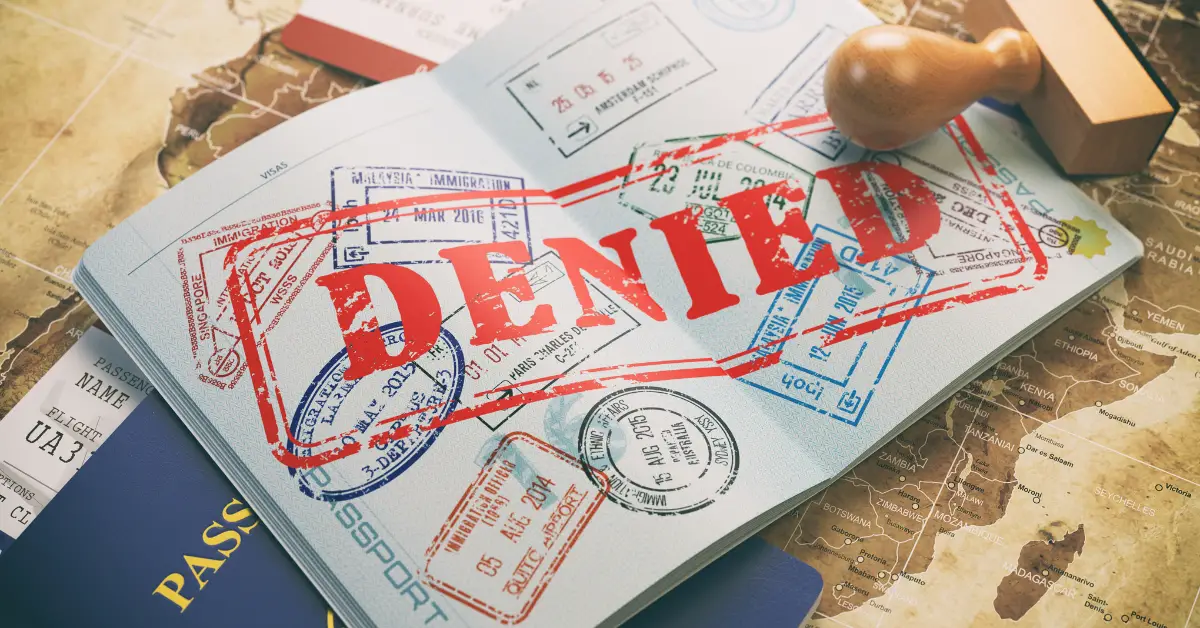
Receiving a visa denial can be frustrating and disheartening.
However, understanding the reasons behind it can help you improve your chances of success in future applications.
Visa applications can be denied for various reasons, often depending on the country’s immigration policies and the applicant’s specific circumstances.
Below, we delve into some common reasons why visa applications might be denied and offer tips on how to address these issues:
Incomplete or Incorrect Information
- Issue: Providing inaccurate or missing information on the application form, supporting documents, or during the Interview can raise doubts about your credibility and intentions.
- Solution: Ensure all information is accurate, complete, and matches the supporting documents.
Inadequate Financial Support
- Issue: Failing to demonstrate sufficient financial resources to support your stay in the destination country can lead to denial.
- Solution: Provide proof of income, bank statements, or sponsorship documents to show financial stability.
Travel History and Purpose
- Issue: Previous immigration violations, overstaying visas, or gaps in travel history can raise concerns about compliance with immigration laws. Unclear or inconsistent reasons for travel can also raise suspicion.
- Solution: Explain any past issues and demonstrate strong ties to your home country. Clearly state your purpose of visit and provide supporting documentation, such as travel bookings or invitations.
Medical Inadmissibility
- Issue: Certain health conditions or concerns might make you inadmissible to the destination country.
- Solution: Check visa requirements for any health-related restrictions and be prepared to provide medical documentation if needed.
Security Concerns
- Issue: A criminal record, involvement in illegal activities, or suspected ties to terrorism can lead to denial for security reasons.
- Solution: Be honest about any past involvement with law enforcement and explain if necessary.
Ineligibility for Visa Category
- Issue: Applying for the wrong visa type for your intended purpose of travel can lead to denial.
- Solution: Understand the different visa categories and choose the one that best aligns with your travel plans.
Other Factors
- Issue: Technical errors or inconsistencies in the application or failing to comply with interview procedures can lead to denial.
- Solution: Be attentive to technical details and honest during the interview process.
Additional Tips
- Research and Preparation: Each country and visa category has its criteria and reasons for denial. Researching and understanding these criteria is crucial.
- Seek Professional Help: If you receive a denial, review the reason carefully and consider seeking professional help for future applications.
- Embassy/Consulate Guidance: Contacting the embassy/consulate of the destination country for specific details and guidance can be very helpful.
By understanding these common reasons for visa denial and taking proactive steps to address them, you can significantly strengthen your application and increase your chances of success in securing your travel visa.
Visa Duration and Validity

Traveling internationally requires excitement, planning, and a thorough understanding of visa requirements, specifically visa duration and validity.
These two aspects of any travel document are essential for smooth travel, and comprehending them ensures you remain compliant with immigration laws.
Visa Duration
- Definition: Visa duration refers to the maximum period you can stay in the destination country after entering. This is different from the validity period and is crucial for planning the length of your stay.
- Start Date: The duration typically starts from the date of entry or activation of the visa, not from the date of issuance. This distinction is vital for planning your arrival in the destination country.
- Variability: The duration can vary significantly depending on the visa type, your nationality, and the country’s regulations issuing the visa. It is important to check the specific terms for your situation.
- Entry Type: Some visas grant single entry, while others allow multiple entries within the duration period. This flexibility can be crucial for travelers planning to visit multiple countries or return to the destination country within a short period.
Visa Validity
- Definition: Visa validity refers to the time you can use the visa to enter the destination country. It is often different from the visa duration, typically expiring earlier.
- Window of Opportunity: Think of it as a “window of opportunity” to use your visa for travel. The validity period can range from a few days to several years, depending on the visa type and the issuing country.
- Analogy: Imagine your visa as a train ticket. The validity period is like the timeframe you can purchase the ticket (e.g., six months before travel), while the duration is like the journey length (e.g., two weeks).
Important Points to Remember
- Check Your Visa: Always examine your visa’s specific duration and validity, as clearly stated in the document.
- Plan Accordingly: Plan your travel within the permitted duration and ensure you exit the country before the visa expires to avoid legal complications.
- Consequences of Overstaying: Overstaying your visa is a serious offense, leading to penalties and potential future travel restrictions.
- Possibility of Extension: Some countries offer visa extensions under specific circumstances, but it is not guaranteed and should not be relied upon.
Additional Tips for Travelers
- Apply for Longer Validity: Consider applying for a visa with a validity period longer than your intended stay, allowing for potential travel flexibility.
- Registration Requirements: Check if your visa requires registering with immigration authorities upon arrival in the destination country.
- Understand Conditions: Familiarize yourself with any conditions attached to your visa, such as restrictions on travel within the country or permitted activities.
Understanding visa duration and validity is crucial for responsible and worry-free travel.
By carefully planning your trip within the allowed timeframe, you can ensure a smooth and enjoyable experience in your chosen destination.
Remember, adhering to visa regulations keeps you legally compliant and opens the door to more enriching and stress-free travel experiences.
What is the Difference Between a Passport and a Visa?
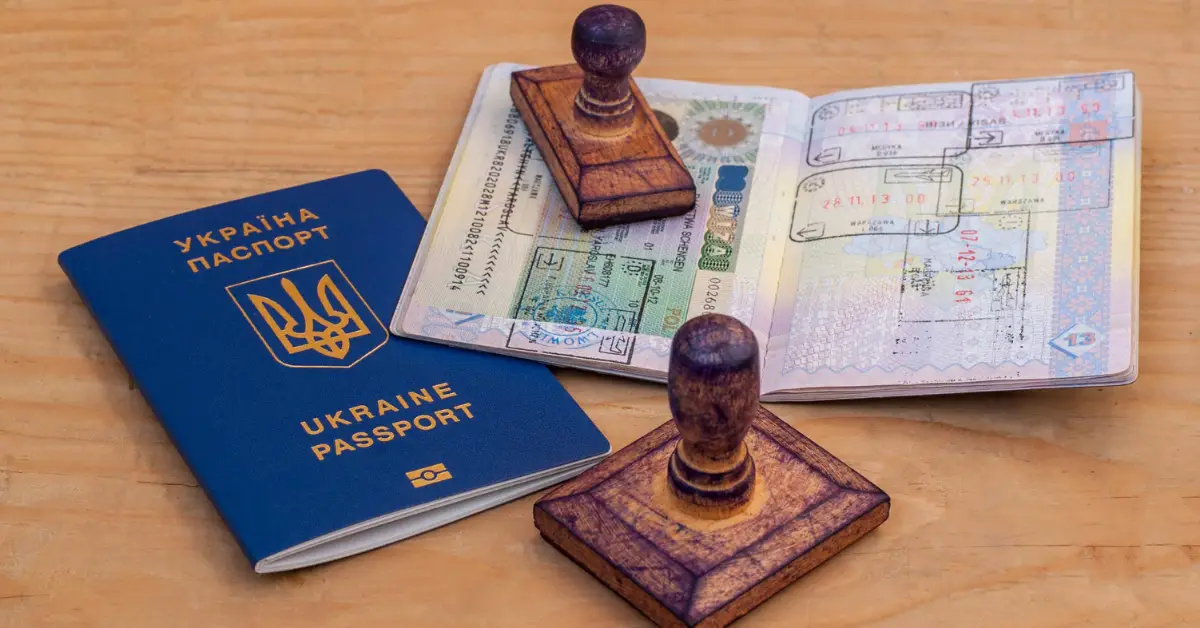
Passports and visas are both essential documents for international travel, but they serve different purposes:
Passport
- National identity document: Issued by your home country, it proves your nationality and allows you to travel internationally.
- Travel document contains your personal information, photo, and signature and is official identification when crossing borders.
- Universal recognition: Accepted by all countries for travel, allowing you to enter and leave your home country.
Visa
- Entry permit: Issued by a foreign country, it grants permission to enter and stay within their territory for a specific purpose and period.
- Conditional document: Attached to your passport, it specifies limitations like the duration of your stay, permitted activities, and sometimes entry points.
- Not universally required: Not all countries require visas for all nationalities. Some may have visa-free entry agreements for specific countries or short stays.
Here is a simple analogy
- Think of your passport as your driver’s license. It proves your identity and allows you to operate a vehicle (travel internationally).
- Think of a visa as a parking permit. It permits you to park (stay) in a specific location (country) for a certain timeframe and under specific conditions.
Key Differences
- Issuing authority: Passport issued by your home country, visa issued by a foreign country.
- Purpose: Passport for general travel and identification, visa for specific entry, and activity permissions.
- Universality: Passport universally accepted, visa not required for all countries or travel purposes.
- Validity: Passports are valid for longer periods (typically 5-10 years), and visas are valid for shorter durations (days, weeks, months).
In conclusion, a passport is your key to international travel, while a visa is a specific permission a foreign country grants to enter and remain within its borders.
Both documents are essential for navigating the world, and understanding their differences will ensure smooth and worry-free travel experiences.
What Is the Difference Between a Visa and a Residence Permit?

While both visas and residence permits allow you to stay in a foreign country, they serve distinct purposes and offer different rights and privileges.
Here is a breakdown of the key differences:
Purpose
- Visa: Grants temporary permission to enter and stay in a country for a specific purpose, such as tourism, business, or study. It typically has a limited validity period and may restrict your activities within the country.
- Residence permit: Grants permission to live in a country for an extended period, often with the possibility of renewal or eventual permanent residency. It allows you to work, study, and enjoy more freedom of movement and activities than a visa.
Validity
- Visa: Typically valid for days, weeks, or months, depending on the type and purpose.
- Residence permit: Valid for months or years, with the possibility of extension or renewal.
Rights and privileges
- Visa: Usually restricts your activities to the specific purpose for which it was issued. You may not be allowed to work, own property, or access certain social benefits.
- Residence permit: Grants you more rights and privileges similar to citizens, including the right to work, study, own property, access healthcare and social benefits, and travel freely within the region.
Application process
- Visa: This can be relatively straightforward, often requiring proof of financial support, travel itinerary, and return tickets.
- Residence permit: Typically involves a more complex application process, including proof of income, housing, and health insurance. It may also require demonstrating strong ties to the country.
Here is an analogy
- Think of a visa as a temporary visitor pass to a club. It allows you to enter and enjoy the club’s amenities for a limited time, but you may only have full access to some facilities or membership privileges.
- Think of a residence permit as a club membership. It grants you ongoing access to the club and its benefits, including working, participating in activities, and contributing to its operations.
In summary
- Visas are for short-term stays with specific purposes.
- Residence permits are for longer-term stays with greater rights and privileges.
Choosing the right document depends on your travel goals and desired level of integration into the host country.
Always research the specific requirements and application process for visas and residence permits in the country you wish to visit.
What Are Electronic Travel Authorizations?

Electronic Travel Authorizations (eTAs) are a relatively new form of travel document gaining popularity, offering a streamlined and often faster way to enter certain countries.
Here is a breakdown of what they are and how they work:
What is an eTA?
- An eTA is an electronic document that pre-authorizes your travel to a specific country, typically for short-term stays and visa-exempt nationalities.
- It’s linked to your passport electronically and eliminates the need for a traditional paper visa.
- Some countries refer to similar documents as Electronic Visas (eVisas) or Travel Authorizations.
How does an eTA work?
- You apply online by providing your personal information, travel details, and passport number.
- The application is processed electronically, and you receive a decision within a short timeframe (usually days).
- If approved, you can print out the eTA document or store it electronically on your smartphone.
- Upon arrival, you present your valid passport and eTA to immigration officials for entry.
Benefits of eTAs
- Convenience and speed: Applying online is faster and more convenient than traditional visa applications.
- Cost-effective: eTAs often have lower fees compared to visas.
- Streamlined process: No need for embassy or consulate visits.
- Faster entry: Shorter processing times at immigration upon arrival.
Countries using eTAs
- Canada, Australia, New Zealand, Singapore, and several European countries are among the many countries using eTAs or similar documents.
- The specific countries and requirements vary, so it is crucial to research the eTA requirements for your desired destination.
Important points to remember
- Not all nationalities are eligible for eTAs.
- eTAs typically have validity periods and restrictions on activities permitted within the country.
- Overstaying your eTA is a serious offense and can lead to penalties and future travel restrictions.
In conclusion, eTAs offer a convenient and often faster alternative to traditional visas for short-term travel to certain countries.
Check your destination’s specific requirements and eligibility before applying for an eTA.
Joint Visa Schemes

Joint visa schemes are agreements between two or more countries that allow travelers to enter and stay in both countries with a single visa.
This can be a great way to experience multiple destinations on one trip without the hassle of applying for separate visas for each country.
Here are some key aspects of joint visa schemes:
Types of Joint Visa Schemes
- Single visa with multiple entries: This allows you to enter both countries multiple times within the visa’s validity period, as long as you comply with the individual entry and stay limits for each country.
- Multiple entry visa with specific validity periods in each country: This allows you to enter each country multiple times. However, you might have different validity periods for each country within the overall visa validity.
- Transit visa with access to specific areas: This allows you to transit through both countries without formally entering but might allow you to access certain areas within the transit zones.
Benefits of Joint Visa Schemes
- Convenience: Saves time and money by applying for only one visa instead of separate ones for each country.
- Flexibility: Allows you to explore multiple destinations on one trip with ease.
- Boosted tourism: Encourages travel between participating countries and benefits local economies.
Examples of Joint Visa Schemes
- Schengen Area: This is the most well-known joint visa scheme, encompassing 26 European countries where you can travel freely with a single Schengen visa.
- Andean Community: Bolivia, Colombia, Ecuador, Peru, and Venezuela offer a joint visa for tourism purposes.
- Benelux Union: Belgium, Luxembourg, and the Netherlands have a joint visa scheme for short-term stays.
- Central American Free Trade Agreement (CAFTA-DR): This agreement allows visa-free travel between Guatemala, El Salvador, Honduras, Nicaragua, Costa Rica, Dominican Republic, and Panama for citizens of member countries.
Important Points to Remember
- Not all countries participate in joint visa schemes.
- Eligibility requirements and visa types can vary between schemes.
- Always check the specific conditions and limitations of the joint visa scheme before applying.
- Some joint visas might have restrictions on activities permitted in each country.
In conclusion, joint visa schemes offer a convenient way to travel between multiple destinations with a single visa.
However, it is crucial to carefully research the specific details of the scheme and ensure you meet all the requirements before applying.
What Is an Exit Visa?

An exit visa, also known as a departure visa or emigration permit, is an official document issued by a government that grants permission to leave its territory. It is the opposite of an entry visa, which allows you to enter a country.
Why are exit visas required?
Exit visas are not universally required, but some countries implement them for various reasons, including:
- Monitoring and control: Governments might use exit visas to track the movement of their citizens and prevent unauthorized departures, particularly for individuals with outstanding debts, legal issues, or national security concerns.
- Revenue generation: Some countries charge fees for exit visas, which can be a source of income for the government.
- Foreign exchange control: In countries with strict currency controls, exit visas might limit the amount of foreign currency citizens can take out of the country.
Types of exit visas
- Single exit visa: Valid for a single departure from the country.
- Multiple exit visa: Valid for multiple departures within a specified period.
- Transit visa: This allows you to pass through a country without formally entering but might not require an exit visa, depending on your nationality and transit duration.
Who needs an exit visa?
The requirement for an exit visa can depend on various factors, including:
- Nationality: Some countries require exit visas for all citizens, while others only require them for certain nationalities.
- Length of stay: Some countries might require exit visas for individuals who have overstayed their visas or permits.
- Employment status: Certain professions or government jobs might require employee exit visas.
How to obtain an exit visa?
The exit visa process can vary depending on the issuing country. It typically involves:
- Completing an application form will require providing personal information, travel details, and reasons for departure.
- Paying any required fees: Exit visa fees can vary significantly between countries.
- Supporting documentation might include proof of financial resources, travel documents, and employment status.
- Attending an interview: Some countries might require an interview with immigration officials as part of the application process.
Important points to remember
- Always research the specific exit visa requirements for the country you are leaving.
- Apply for an exit visa well before your travel date to avoid delays.
- Failing to comply with exit visa requirements can lead to penalties, such as fines, travel bans, or even detention.
In conclusion, while optional, exit visas can be crucial depending on your travel plans and the specific country you are leaving from.
Understand the requirements and application process to ensure a smooth and hassle-free departure.
Countries Require Exit Visa
While the number of countries requiring exit visas has steadily decreased over the past few decades, some countries still maintain this policy.
Here is a non-exhaustive list of countries where you might need an exit visa, categorized by region:
Africa
- Angola
- Burundi
- Chad
- Democratic Republic of the Congo
- Equatorial Guinea
- Eritrea
- Ethiopia
- Gabon
- Guinea
- Liberia
- Mauritania
- Niger
- Sierra Leone
- Somalia
- South Sudan
- Sudan
Asia
- Afghanistan
- Bangladesh (for certain professions)
- Bhutan
- Cambodia (for overstays)
- Iran
- Iraq
- Kuwait
- Laos (for overstays)
- Lebanon
- Myanmar (for overstays)
- Nepal (for overstays)
- Oman
- Qatar
- Saudi Arabia
- Syria
- Tajikistan (for overstays)
- Turkmenistan
- United Arab Emirates (for certain professions)
- Uzbekistan (for overstays)
- Yemen
South America
- Bolivia
- Suriname
Oceania
- Nauru (for overstays)
- Palau (for overstays)
Europe
- Belarus
- Russia (for overstays)
- Ukraine (for overstays)
Please note
- This list is incomplete and may change over time.
- Requirements can vary depending on your nationality, destination country, and length of stay.
- Before your trip, check the latest exit visa requirements with the relevant embassy or consulate.
- Some countries might issue exit visas at the airport upon departure, but fees and processing times can vary.
Additional tips
- Consider applying for a multiple-entry visa if you plan to visit multiple countries during your trip.
- Ensure you have the necessary funds to cover exit visa fees.
- Always keep copies of your travel documents and exit visa with you.






